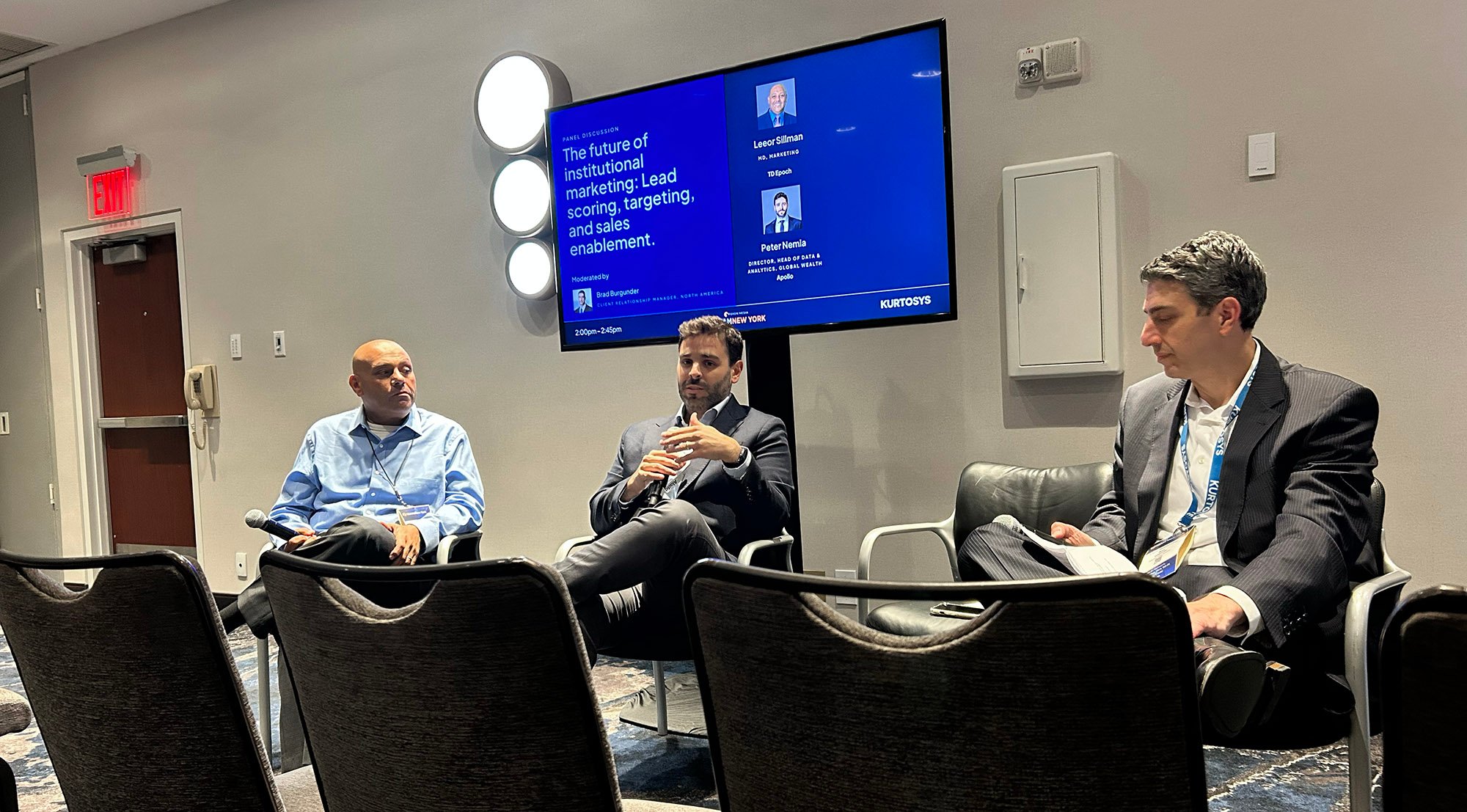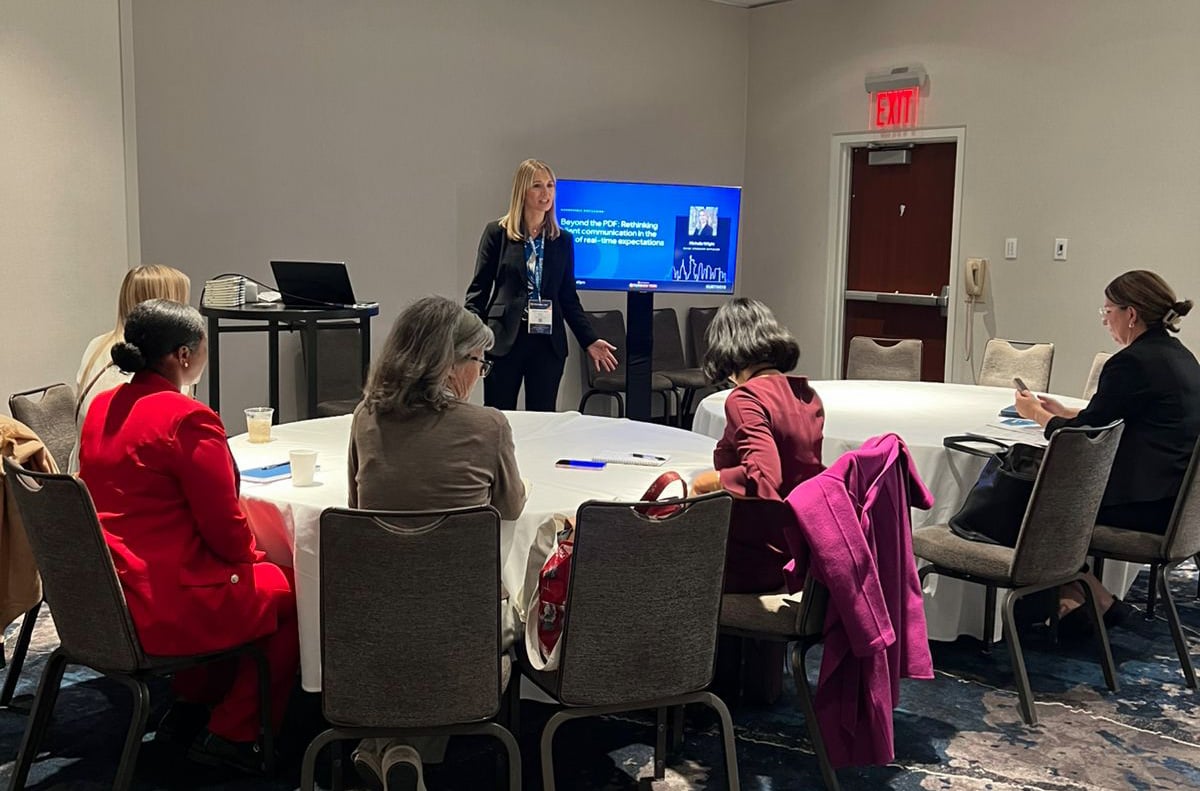It’s no surprise that AI emerged as a central theme across both TSAM London and TSAM New York this year. From implementation and adoption to practical applications in Generative Engine Optimisation (GEO) and day-to-day workflows, AI continues to shape how asset managers think about efficiency, personalisation, and scale.
I had the privilege of moderating a few sessions at TSAM New York this year, and here are the themes that stood out for the marketing and client services teams in the asset management industry.
AI in action: From planning to practicality
Many asset managers are actively implementing AI initiatives. If your firm is still in the planning stage, there is no need to worry; you are not alone. We are still in the early adoption phase, and it’s important to temper overenthusiasm with a dose of caution and carefully consider the risks. The biggest opportunity lies in efficiency: firms are focusing on eliminating low-level tasks so that teams can spend more time on strategy, client engagement, and growth.
A recurring theme was the importance of system integration. Firms are exploring ways to connect AI with their CRM and data warehouses to streamline data management, capture client sentiment, and automate reporting. And yes, sales and marketing need to work closely together to build strong pipelines and help drive sales. Together, these teams can leverage AI and marketing automation to deliver timely, relevant, insight-led content across channels.

Leeor Sillman, Peter Nemia, and Brad Burgunder at TSAM New York 2025.
Aligning marketing and distribution through digital, client-centric strategies in asset management
One message was clear: the disconnect between marketing and distribution is holding firms back. As client expectations rise, seamless, data-driven experiences are no longer a nice-to-have.
Alignment means more than collaboration. Marketing and distribution need to publish consistent content, timely reporting, and personalised client portals that meet the needs of investors.
During our recent research on What Institutional Investors Want, it was found that 42% of asset owners would divest based on poor reporting, while almost two-thirds of respondents (65%) rated their current reports only as “average” or worse. There is significant room for improvement when it comes to providing accurate, compliant reports that are distributed on time, and the alignment between departments in the investor lifecycle is key.
From SEO to GEO: Preparing for the age of generative search
Our Chief Product Officer, Michelle Wright, hosted a discussion around the topic of GEO, an area that we have explored extensively at Kurtosys. It’s all about making sure that content is discoverable in AI and optimising content for AI search as more consumers use conversational tools like ChatGPT and Gemini to conduct research. Michelle discussed this topic in her latest blog here.
Do | Don’t |
|---|---|
Make key content easily accessible (landing pages instead of PDFs) | Lock content behind pop-ups, forms or gated PDFs |
Optimise headings & copy for AI-style queries | Use unclear headings or jargon that AI and users may not understand |
Monitor traffic for unusual spikes and patterns | Assume all automated traffic is harmless and ignore monitoring |
Apply a balanced access strategy (allow AI where appropriate) | Block all traffic indiscriminately, limiting discoverability |
Equally important is finding the right balance between blocking malicious scraping and enabling beneficial crawling that leads to genuine user journeys. Sunil Odedra, our Chief Technology Officer, joined Michelle for a pre-TSAM discussion, further exploring this topic. You can watch the full interview here.

Michelle Wright presenting her roundtable “Beyond the PDF: Rethinking client communication in the age of real-time expectations” at TSAM New York 2025.
Interesting takeaways from TSAM New York:
- You can now boil the ocean. With AI now doing the heavy lifting, technology and marketing teams are uncovering hidden opportunities within large RIA (Registered Investment Adviser) datasets – identifying high-potential leads that can then be qualified and passed to sales.
- Virtual wholesaler: Organisations are experimenting with AI to mimic the voice of the wholesaler, sending personalised recommendations and product updates at scale. Once engagement is established, the human wholesaler can take over. AI can replicate the tone, timing, and style of a real wholesaler’s communication, extending the reach to more people at once. This hybrid approach extends reach, reduces costs, and allows AI to analyse engagement data to prioritise real leads and surface new opportunities.
- AI for everyday efficiency: Many firms are already saving hours of manual work by using AI notetakers that automatically log meeting notes in CRMS and draft personalised “thank you emails”, ready for human review and approval before sending.
There was no shortage of innovative ideas and forward-thinking discussion at TSAM this year. It’s clear that as technology evolves, the focus remains on what matters most: enhancing client experiences, driving efficiency, and creating stronger alignment across teams.
FAQ
How are asset managers integrating AI into their workflows?
Firms are connecting AI tools with CRMs and data warehouses to streamline client data management, capture sentiment, and automate reporting. This integration allows marketing and distribution teams to collaborate more effectively and deliver timely, insight-driven content across multiple channels.
Why is alignment between marketing and distribution so important?
TSAM 2025 highlighted that misalignment between marketing and distribution teams slows growth. Clients now expect seamless, data-driven experiences, so firms must ensure consistent content, accurate reporting, and personalised portals. Research cited in the event showed that 42% of asset owners would divest due to poor reporting, underscoring the need for better cross-department collaboration.
What is Generative Engine Optimisation (GEO) and why does it matter?
GEO, or Generative Engine Optimisation, is the process of optimising content for AI-driven search platforms like ChatGPT and Gemini. Instead of focusing solely on traditional SEO, GEO ensures that your content is discoverable and accurately represented in AI-generated answers. This is increasingly vital as more investors and clients use conversational AI tools for research and decision-making.
How can asset managers prepare for the shift from SEO to GEO?
Asset managers should adapt their content strategies by writing clear, authoritative, and AI-friendly copy. Structuring data so AI systems can interpret it accurately. Balancing site accessibility by blocking malicious scraping while allowing beneficial AI crawling.





